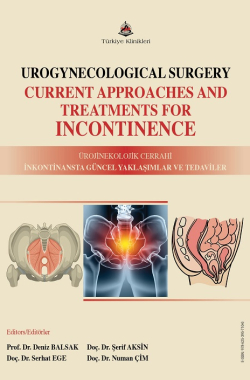THE ROLE OF HORMONE REPLACEMENT THERAPY IN POSTMENOPAUSAL PELVIC FLOOR DYSFUNCTIONS AND HOLISTICMANAGEMENT STRATEGIES
Fatih Omurca
Nişantaşı University, Faculty of Medicine, Department of Gynecology and Obstetrics, İstanbul, Türkiye
Omurca F. The Role of Hormone Replacement Therapy in Postmenopausal Pelvic Floor Dysfunctions and Holistic Management Strategies. In: Balsak D, Çim N, Ege S editors. Urogynecological Surgery Current Approaches and Treatments for Incontinence. 1st ed. Ankara: Türkiye Klinikleri; 2025. p.81-90.
ABSTRACT
The significant decrease in estrogen levels that occurs during the postmenopausal period leads to histological, biomechanical, and functional deteriorations in pelvic floor structures.
These postmenopausal changes manifest with various clinical presentations such as pelvic organ prolapse (POP), urinary incontinence (UI), genitourinary syndrome (GSM), and sexual dysfunctions. In this review study, the pathophysiology of postmenopausal pelvic floor dysfunctions, clinical symptomatology, therapeutic potential of hormone replacement therapy (HRT), and multidisciplinary treatment approaches are comprehensively discussed in light of current scientific literature.
The safety profile and application methods of HRT, along with pelvic floor physiotherapy, lifestyle modifications, and surgical intervention options, have also been evaluated. This holistic perspective contributes to the development of individualized treatment strategies for the health of postmenopausal women. Hormone replacement therapy (HRT) provides effective management of symptoms related to estrogen deficiency (vasomotor symptoms, sleep disorders, vaginal atrophy) in the postmenopausal period. At the same time, it reduces osteoporosis risk by preserving bone mineral density and has potential positive effects on cardiovascular health. However, patient-based treatment planning should be made by considering individual risk factors (thromboembolic events, breast cancer). Current clinical data support that HRT offers a more pronounced benefit-risk balance when initiated in the early postmenopausal period. In the postmenopausal period, declining estrogen levels lead to histological, physiological, and functional deterioration in pelvic floor structures, increasing the prevalence of pelvic floor dysfunctions that negatively impact women’s quality of life. Vaginal atrophy, urinary incontinence, pelvic organ prolapse, and sexual dysfunction are common clinical manifestations during this stage. Hormone Replacement Therapy (HRT), particularly through local estrogen administration, has been shown to increase vaginal epithelial thickness, mucosal vascularization, and elasticity, thereby alleviating symptoms associated with vaginal atrophy. Moreover, the presence of estrogen receptors in pelvic floor muscles suggests that HRT may indirectly enhance pelvic floor muscle tone and connective tissue integrity.
However, the potential risks associated with systemic HRT—such as cardiovascular disease, breast cancer, and thromboembolic events—necessitate careful patient selection and individualized treatment planning. Therefore, HRT should not be considered a standalone treatment for postmenopausal pelvic floor dysfunction but rather a component of a broader, multidisciplinary and holistic therapeutic strategy. This includes pelvic floor physiotherapy, biofeedback, lifestyle modifications, weight management, constipation prevention, psychosocial support, and surgical intervention when clinically indicated.
In conclusion, the effective and sustainable management of postmenopausal pelvic floor dysfunction requires personalized, evidence-based, and multidisciplinary approaches. Within this framework, HRT may serve as a valuable adjunct in symptom relief for appropriately selected patients. Nonetheless, its use must always be guided by a comprehensive risk-benefit analysis, tailored to the individual’s clinical and psychosocial profile.
Keywords: Menopause; Pelvic floor dysfunction; Estrogen deficiency; Hormone replacement therapy; Female urogenital disease
Kaynak Göster
Referanslar
- North American Menopause Society. The 2021 position statement on hormone therapy. Menopause. 2021;28(9):973997.
- International Menopause Society. Global consensus statement on menopausal hormone therapy. Climacteric. 2022;25(1):1-15.
- Demirtürk F. Investigation of pelvic floor muscle strength and affecting factors in various age periods. Contemporary Medical Journal. 2017;7(3):254-264. [Crossref]
- Uysal MF. The effects of Pilates exercises on pelvic floor, balance, posture, and quality of life in postmenopausal women [master's thesis]. Bolu: Abant İzzet Baysal University; 2016.
- Rossouw JE, Anderson GL, Prentice RL, et al. Risks and benefits of estrogen plus progestin in healthy postmenopausal women: Principal results from the Women's Health Initiative randomized controlled trial. JAMA. 2002;288(3):321-333. [Crossref] [PubMed]
- Lethaby A, Ayeleke RO, Roberts H. Local oestrogen for vaginal atrophy in postmenopausal women. Cochrane Database Syst Rev. 2016;(8): CD001500. [Crossref]
- Bo K, Hilde G. Postmenopausal women and pelvic floor muscle training: Scientific evidence and clinical implications. Int Urogynecol J. 2016;27(4):567-569.
- Özbek E. Common urological problems in menopause.
- Coşkuner Avcı A. Pelvic floor functions in postmenopaus al women [specialization thesis]. Istanbul: Health Sciences University; 2024.
- Mayo Clinic. Hormone therapy: Is it right for you? Mayo Clinic website.
- National Institute for Health and Care Excellence (NICE). Urinary incontinence and pelvic organ prolapse in women: Management. NICE guideline [NG123]. 2019.
- World Health Organization. Global health estimates. 2022.
- Yıldırır A, Yılmaz MB, Oto A. The effects of hormone replacement therapy on the cardiovascular system. Turkish Archives of Cardiology. 2004;32(1):17-24.
- Berghmans B, Hendriks E, Bernards A, et al. Conservative treatment of stress urinary incontinence in women: A systematic review of randomized clinical trials. BJU Int. 2015;115(1):33-43.
- Luber KM. The definition, prevalence, and risk factors for stress urinary incontinence. Rev Urol. 2004;6(Suppl 3):S3S9.

